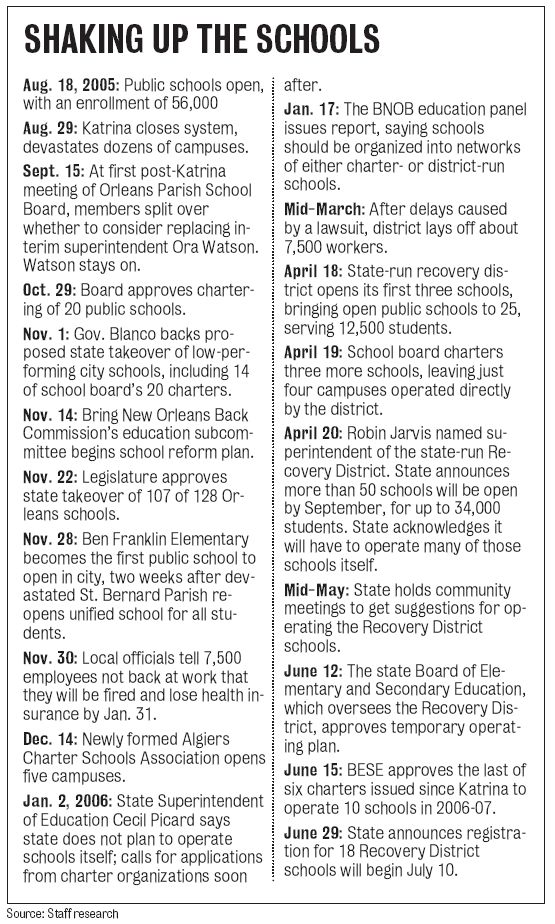
| |
Navigate | HOME | POWERPOINT | INFORMATION | PROPOSAL | CONTACT | CREDITS |
| To
navigate the site,
please use the links above. Powerpoint - A powerpoint that team 5 presented to the class pointing out some concerns and answering some questions Information - Information that Team 5 collected that helped create the proposal Proposal
- Team Five's solution to the Hurricane Katrina
disaster in New Orleans Contact
- E-mail for all the group members as well as
links to each member's website Credits
- Thank you to members of the class and those
who helped with this assignment. |
The lackluster response
of New Orleans's political leaders to
survey the damage shows the prevalent apathy about the city's future.
Pre-election data stated that Republicans are likely to take control in
the state in the coming election, since much of the black Democratic
bloc has moved away and Democratic terms in office are ending. Voters
are mostly disinterested and too busy with rebuilding process to vote.
The change in demographics (from black to white) was expected to impede
black-friendly candidates' election. The best way to
revitalize any city is to ensure that all citizens have access to a
solid education. Even prior to Hurricane
Katrina, the school system in This timeline makes many
references to charter schools, which are independent public schools
specifically focused on meeting high academic standards.
While this is a noble cause, all schools, whether private,
chartered, or public, should offer the best education to all students,
regardless of race or class. As of this
school year, schools have been fighting to maintain a good attendance
rate. As one can see, this has been a
difficult feat in the lower-income areas. What curricula are
needed in If children are made
aware of all there is to learn, a renaissance of intellectualism
ultimately will take place, drawing more colleges, employers, and
industries to the area, causing a rebirth of a city that was thought to
be dead. Also, with understanding of all
issues directly associated with the region, the people of There is already an
initiative to bring quality teachers to the region, called Teach NOLA: Rebuilding our city by teaching our children. Teachers must have at least a Bachelor’s
degree and standard certification. Our
team suggests that this mandate be increased to a Master’s degree. If teachers do not yet have this level of
education, any additional school will be subsidized by the school
district in order to ensure the best possible teachers.
From reading excerpts of interviews with current teachers
on the Teach NOLA website, one can see that those who teach in the area
will have a lot to handle, and the more training they have, the better. What has been the most
noticeable change in terms of student behavior and performance since
the hurricane? “I have noticed a
significant change in the ability to focus on something for long
periods of time. Homework has been a real issue,
a lot of students don’t have the space or light to complete it.
Kids get irritated quicker than usual, and for middle school that is
pretty quick.” “I have noticed students
have behavior problems and have not mastered some of the skills
required at their grade level.” “Students are more on
edge, easily set off. They also seem more aware of things to
worry about, not as carefree.” Do you have anything
else that you would like to share about your current teaching
experience? “Without the experience
of teaching in N.O. post Katrina, I would have lost my mind. It
was the only way I wanted to come back to the city and I thank everyone
who helped make it possible.” “It is important to make
learning fun, because our students need school to be a safe, happy
learning environment.” “It was hard- but I
wouldn’t want to be anyplace else.” “N.O. is a TRUE
educational frontier.” “The more you put into
it, the more you get.” “Though it has been
challenging in many ways, I feel that myself and my co-workers have
made life better for some of Sources: Louisiana Department of
Education. Retrieved November 10, 2006,
from http://www.louisianaschools.net/lde/family/523.html. The Times
Picayune online, Education section. Retrieved
November 12, 2006, from
http://www.nola.com/education/ http://www.nola.com/education/pdf/070306_shakeup.jpg http://www.nola.com/katrina/pdf/092106_enroll.jpg Ritea, Steve.
“System has 1/3 its pre-storm students.” [Electronic
version] Times Picayune,
Thursday, September 21, 2006.
“Teach NOLA: Rebuilding
our city by teaching our children.” Retrieved
November 12, 2006, from http://teachnola.org/teacher-talk.html Culture and history are the top two reasons for why the City
of New Orleans should be rebuilt and preserved. The multi-layered
history of New Orleans stems from the city’s initial function as a
major slave trade port of the United States, which brought in many
Africans, some of whom remained in the city as both slaves, and
eventually, free men and women. Today’s traditions of NOLA’s
neighborhoods grew out of the customs of this wide variety of people in
the late 1800’s. The city established its own style of food,
storytelling, and religious ceremonies (such as the distinctive burial
traditions and cemetery construction practiced in the Lower Ninth Ward
and Holy Cross) because its population was so diverse and unique,
unmatched in any other American city. Below, we consider just some of
the cultural aspects that are vital to the spirit of New Orleans: PARADES |


